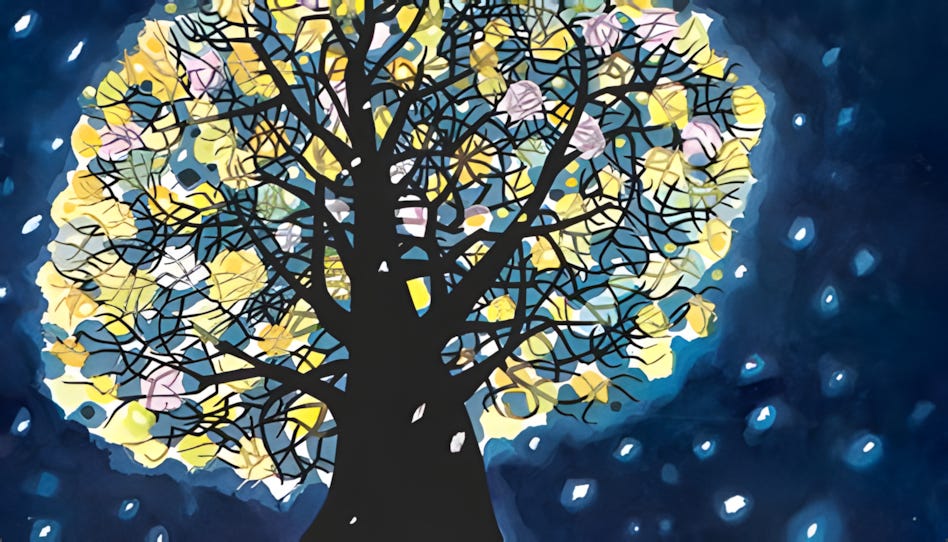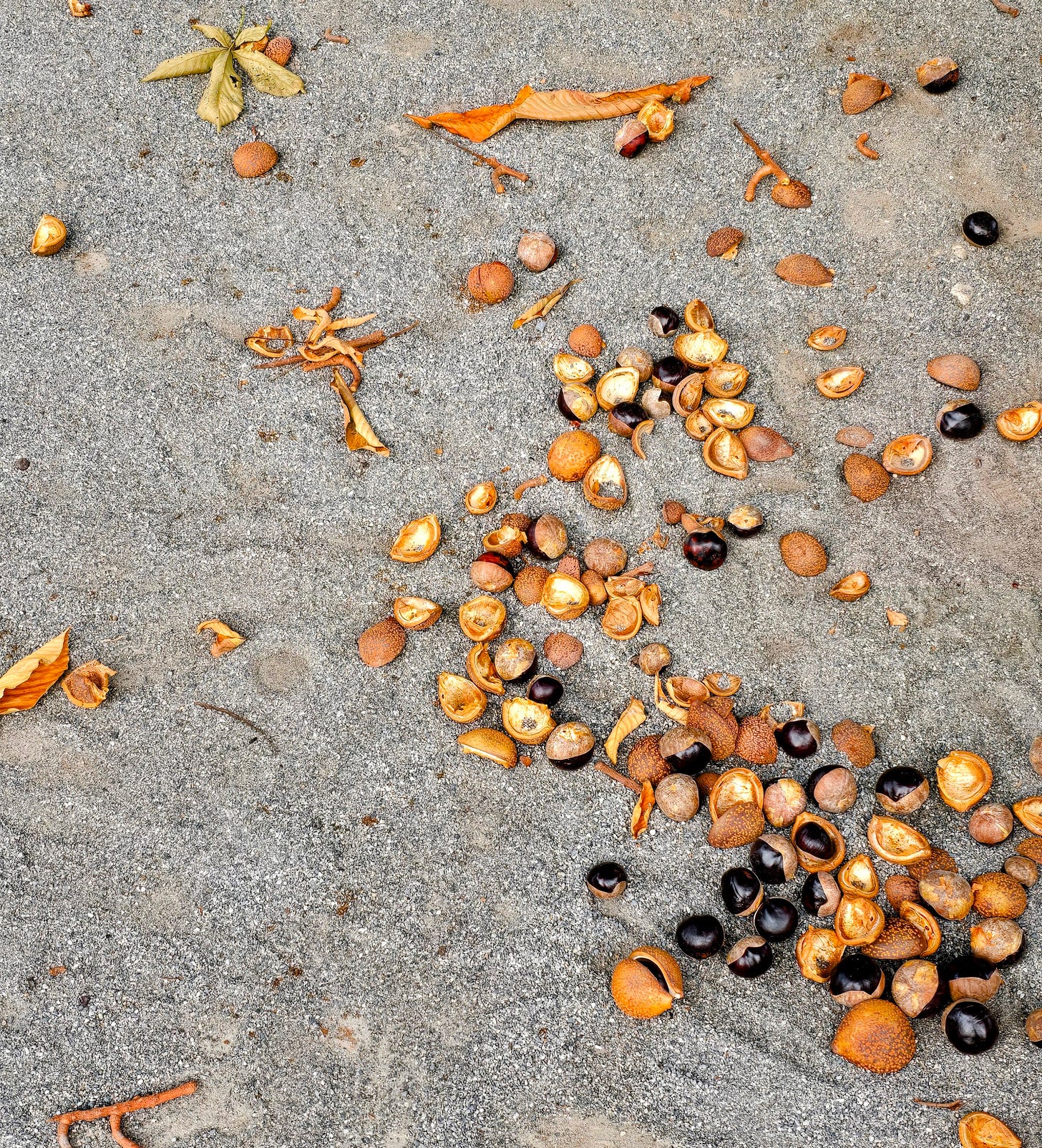The conker tree
A walk in the park can take you further than you expect

Walking early one morning last week in the nearby park, I was distracted by the sound of cicadas. A few days before, following some cooler nights, they had been absent. But with the return to warmer, muggy weather, they were back, singing with the desperate cadence of a faltering summer season.
As I looked up in my surprise at their song, I stumbled. On a stone, I thought.
But looking down, I saw it was a large horse chestnut seed still in its casing. Wow, I said to no one in particular. A conker!
🌳
As a child in Devon, I used to play with conkers.1 We’d run the seed through with a skewer and put a piece of white string through them, secured with a knot and with a protruding length of about a foot at the other end. We’d then smash them against an opponent’s conker, which they’d suspend at arm’s length, employing a sling action that would bring the full force of your conker bearing down on the other’s, like planets jostling for supremacy in a small solar system.
At my primary school or at home with my brothers, these were battles of strategy, craft, technology, and, occasionally, brute strength. The conkers could be used fresh from the new season, in which case the bigger and rounder the better. Or they could be cured in vinegar or simply wrapped in newspaper for a year to produce “one yearers” that might, if well preserved, beat all comers with their gnarled toughness. How we cheered and cherished the sight of an opponent’s gleaming conker smashed to pieces, leaving the pathetic string sadly dangling!
But, though I didn’t admit this at the time, the greater joy was finding and collecting the conkers. Few pleasures of my childhood compared with that of the September season of discovering the first fallen conkers below the browning leaves of the horse chestnut trees after the autumn’s first gales.
The shiny fruits emerged as if newly polished for my benefit from their spiky cases. They were small miracles of craft, more accomplished even than the carvings produced by my uncle, a talented carpenter. While I was happy to use them as instruments of childlike war, I silently coveted their pristine wood finish. They were the true delight of autumn; even the smoothness of their surface felt like gossamer (not a word I knew then) in my boyish hands.
🌳
One autumn was especially memorable. For my birthday that summer, my twin brother and I had received our first new bicycles. They were shiny and red and had three gears that you changed with a twist of the hand on the handlebar. On the back, they had large panniers that would be perfect for collecting conkers. Our birthday is in July, so we had to wait impatiently for September to arrive to put the panniers to their pre-destined use.
On the first suitable Saturday that month, once the weather had cooled, we set off to plunder the local conker trees. The new bikes gave us greater range; we were upgraded versions of ourselves. There weren't any conker trees on the farm; you’d find them in parks and in old parks or near manor houses.2 That year, we toured the local sites with a new air of confidence, almost of assumed ownership, looking to harvest the treasured conkers.
I’m ashamed to say that we weren't above giving gravity a helping hand by throwing sticks into the trees to bring down any promising-looking fruit. Beating the local competition to the best conkers on our shiny new steeds, we crammed our bags to overflowing. We then returned home in triumph, our bicycles wobbling along the country lanes under the strain of our crammed panniers.
I’ve no idea how many battles were won or lost that autumn. But the memory of the collecting, of the foraging among the acrid discarded cases beneath the still leafy trees on that cool autumn day, remains with me.
🌳
I mentioned in a recent post an anthology of poetry that would create a lifelong habit of reading poetry. One of the poets in that collection was Richard Eberhart, whose poem The Cancer Cells (“a virulent laughing gang”) was one of my favourites in the book.
Eberhart (1904–2005) also wrote a poem called The Horse Chestnut Tree. It’s almost as if he’d been watching me in the Devon countryside all those years ago. He captures us perfectly as belonging to “sporadic but tenacious droves” and gets it just right when he says that for the children (for me),
Desire is in them for a shining amulet.
And I was certainly among those who
With shrill arms they fling to the higher branches,
To hurry the work of nature for their pleasure.
I’d forgotten that we’d sometimes trespass on private property to collect our treasured amulets, but was reminded when I read this passage in Eberhart’s poem where he reflects upon his observation of the conker collectors:
We, outlaws on God’s property,
Fling out imagination beyond the skies
Wishing a tangible good from the unknown.
🌳
When I moved to Ankara over 15 years ago, I was happy to find on our street conkers identical to the ones I’d known as a boy. My sons were of an age to play with them, and I looked forward to teaching them how. Sadly, however, they showed little interest in the conkers or my childhood exploits as a conker-pursuing outlaw.
🌳
The horse chestnuts I’d stumbled across in Japan are native to these islands and slightly different from the European species. The casings are smooth, lacking the protective spikes of the ones I knew. But like the conker tree, they have a place in the culture, though it’s a very different one.
While European horse chestnuts are considered inedible, the variety native to Japan is turned, though a long and laborious process to remove their bitterness, into sweets, often mixed with “mochi” and bean paste. Until very recently, these sweets would have been a rare winter treat for children in rural communities in Japan. They are still sold as “omiyage”3 in some towns and cities.
🌳
Another more familiar cultural appearance of the tree is in a story that every Japanese person seems to know because it’s in the national primary school textbook. This is the illustrated story of The Mochimochi Tree (1971), written by Ryusuke Saito and illustrated by Jiro Takidaira.
It’s the story of a young boy who lives with his grandfather in the mountains. He’s afraid of the large horse chestnut tree in front of the house, which he calls the "Mochimochi Tree.”4 He needs to be accompanied by his grandfather to walk past it at night on the way to the outhouse toilet, a point of shame for him.
But one night, the grandfather is taken ill and needs a doctor. Determined to help his grandfather, the boy conquers his fears and hurries past the tree in the darkness to summon help from the nearby village. The grandfather is saved, and the boy learns a valuable life lesson about dealing with fear.
🌳
There’s also a rather beautiful haiku about horse chestnuts, written by the poet Hisajo Sugita (1890–1946):
橡の実の つぶて颪や 豊前坊
Rough translation: Seeing many big horse chestnuts falling at Buzenbou (a shrine in Fukuoka Prefecture) is like wind blowing down the mountains.
Or:
"Horse chestnuts fall
Like pellets in the mountain wind -
Buzen-bō
Sugita was one of the most talented haiku writers of the early 20th century. She was for a time celebrated as such before being expelled and calumnied by the male-dominated haiku circle of which she’d become a part.
She died in a sanatorium, possibly of complications brought on by malnutrition. To paraphrase Eberhart, it seems Sugita became “an outlaw on men’s property.”5
🌳
Back in the park, after recovering my balance, I saw a small grove of horse chestnuts that spilled onto a small gravelled sports field. Near one of the trees and next to a simple bench, there was a small pile of conkers and their cases.
Perhaps a boy or girl had played with them or just wanted to admire their beauty. Though no longer a conker outlaw, fifty years later and more than 6,000 miles away, I was suddenly closer than I imagined to those childhood September days.
I smiled at the gleaming conkers one last time before I turned to continue on my way.
American readers might know them as “buckeyes.” The trees in Europe and the US are from the same genus.
They are an introduced species valued for their size and shape as well as their ornate bright flowers, which have sometimes earned them the nickname “candle tree,” which I’ve heard used in England.
A gift bought home by travellers for friends and family. It's virtually a social obligation to do this in Japan.
“Mochimochi” means soft or squishy in Japanese. “Tochi” is the Japanese word for horse chestnut. The actual word for the tree in Japanese is 栃の木, Tochinoki.
For a detailed account of her harrowing story, see this article (registration may be required).








It's a dreamy painting isn't it?
I'm finding that as I get older and go hunting for them, some memories come back to me quite vividly. Of course, most of my childhood is just a blur :)
Jeffrey, I cannot tell you how much I love this essay. From the description of your childhood armory, and the remarkable ingenuity with which you created your weapons and strategies (stringing the conkers together, hardening them over the winter) to the stories of the mochimochi tree and the tragic details of Sugita’s life, you had me spellbound. “The new bikes gave us greater range; we were upgraded versions of ourselves.” Now that’s a one-sentence statement of how it feels to be a master of the universe.
I did not know that horse chestnuts were found outside of the U.S. My first experience with them was when we moved into our second house, the one I live in now. It was one of two trees we saved. (Our yard was almost as big a horror as our house, and that is saying something.) My kids called the fruit “spikes,” and had many battles with them. My daughter and her friends hung their Barbie dolls by the neck from its branches. As far as I know, this is the only horse chestnut in the neighborhood. They’re regarded as nuisance trees. But mine is a gift. As is this essay.